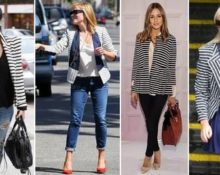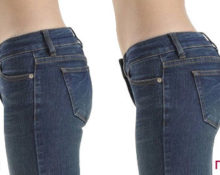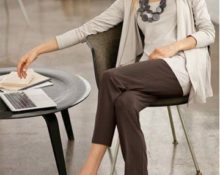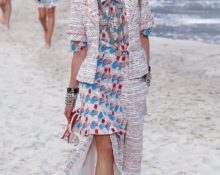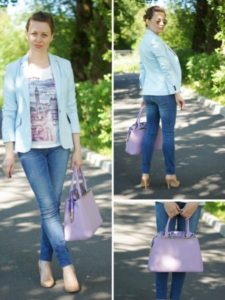 Women's jackets are an integral part of the wardrobe of the fashionable, stylish and elegant. The color, silhouette and style of the jacket are responsible for an impeccable female image. A neat cut and well-executed fitting ensure an impeccable fit. The ideal appearance largely depends on the professionalism of the tailor and the quality of the WTO (wet heat treatment). Duplication is responsible for shape formation (with subsequent shape stability). It is this important aspect that will be discussed in the article.
Women's jackets are an integral part of the wardrobe of the fashionable, stylish and elegant. The color, silhouette and style of the jacket are responsible for an impeccable female image. A neat cut and well-executed fitting ensure an impeccable fit. The ideal appearance largely depends on the professionalism of the tailor and the quality of the WTO (wet heat treatment). Duplication is responsible for shape formation (with subsequent shape stability). It is this important aspect that will be discussed in the article.
Duplicating parts
Duplication - this is the connection of the main cut details with hot-melt adhesive cushioning material. The purpose of this event is to impart dimensional stability to the finished product. Duplication can be frontal (“the entire part is glued”) or zonal (some separate area).
The first question that a newbie has is: What parts of the jacket need to be duplicated? Unfortunately, in professional practice, there is no clear answer to this question.The same part can be duplicated in one case and not “glued” in another. A number of factors influence a tailor's decision.
The main principle that helps make the right decisions can be formulated as follows: To understand WHAT to compact, you need to understand WHY you are doing it. In general, this approach is the key to solving any problem. If you understand the meaning of the process, you don’t need numerous rules, because you can make a decision on your own!
So what's the point of duplication?
- Give the jacket a certain shape (hard, soft, standing).
- Keep the created shape as long as possible during wearing.
- Strengthen the edges (bottoms, armholes, necklines), protecting them from unwanted stretching.
- Make particularly important parts resistant to creasing (collars, cuffs, waistband).
- Increase strength in high-load areas (loops, buttons, pockets).
List of jacket parts that are partially or completely duplicated
Frontally (i.e. completely)
 shelves (central parts and barrel);
shelves (central parts and barrel);- coquettes;
- selection;
- upper and lower collar;
- small details of pockets (leaves, “frames”, valves);
- cuffs (if provided by the model);
- straps, belts.
Zonal (partially)
- sometimes the barrel of the shelves is not duplicated completely, but only partially - in the area of the armholes and the bottom;
- share seals for welt pockets;
- additionally - a collar in the lapel area (if necessary);
- lapel fold line;
- in the upper part of the back (neck-shoulder-armhole);
- bottom of the back and sleeves;
- allowance for processing vents (jacket, sleeves);
- sleeve roll (if necessary);
- back neck facing.
Thermoplastic materials for duplicating jacket parts
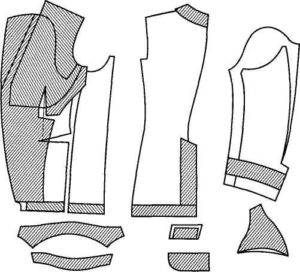 This article is not intended to provide a complete overview of the adhesive materials used in sewing products. The entire range is quite wide and is replenished every year. Some materials are quite narrow-profile (cannot be used at home without special equipment). Therefore, they are used only in factories and production workshops. Below is a brief overview of the hot melt materials most commonly used by professional tailors and hobbyists at home.
This article is not intended to provide a complete overview of the adhesive materials used in sewing products. The entire range is quite wide and is replenished every year. Some materials are quite narrow-profile (cannot be used at home without special equipment). Therefore, they are used only in factories and production workshops. Below is a brief overview of the hot melt materials most commonly used by professional tailors and hobbyists at home.
Doublerin - fabric with glue applied to one side. The best of all possible options. A variety of base fabrics with varying degrees of density (cotton, calico, polyester, viscose, monoelastic, stretch knitwear) allows you to create any model - from strict office to romantic and soft oversized.
The advantages of dublerin are plasticity, strength, drapability, durability. The disadvantage is the high price. However, given a number of extremely positive characteristics, this minus can be considered conditional.
Nonwoven - a paper-like non-woven material made from cellulose fibers (sometimes with the addition of polyester). It comes in different thicknesses and densities - from the thinnest (transparent) to dense (really reminiscent of thick paper).
The main advantage is the budget price. There are many more disadvantages. Thin options are fragile, dense ones are too rigid (parts glued with hard non-woven fabric warp, bulge, and wrinkle like paper). As a rule, the material breaks at the folds and comes off during washing and use.
Definitely not suitable for front duplication. In rare cases, it can be used for zonal, but even in this case it is better to choose thread-stitched options.
Reference! Thread-stitched interlining is an improved non-woven (“quilted” with polyester threads).
Features of using doublerin
When working with understudy, you need to take into account some nuances.
 First of all, you should not skimp on thermal butt, since the final appearance of the jacket largely depends on its quality.
First of all, you should not skimp on thermal butt, since the final appearance of the jacket largely depends on its quality.- Thermoplastic adhesive fabric has a clearly defined thread direction (lobar/transverse) - with varying degrees of elongation.
- Thermal butt parts are cut to a size smaller than the main ones. The general rule: their cuts should not reach 0.3-0.5 cm from the cuts of the main parts.
- In order to achieve the desired shape of the jacket (soft, hard), it is better to make a “test drive” - experiment on unnecessary scraps with options for dubbing of different densities.
- To carry out the operation of “sizing” parts, it is better to use an ironing iron made of thin fabric. When the glue melts, it can seep out, contaminating the iron (after which it will have to be cleaned).
Advice! The iron needs to be washed periodically and always placed with one side up.
- Paired parts are always glued together (folded face to face). Even with the most careful, unhurried actions, WTO leads to slight deformation of parts. When placed together, the parts are deformed (albeit slightly) symmetrically.
Important point! Consists of the movements of the iron. The iron does not need to be dragged (“carried”), but rearranged. Place, press, wait 10–12 seconds (you can first experiment on a test flap), remove, rearrange.
- The “glued” parts are left on the ironing surface (ironing board, table) until they cool completely.
- Some types of non-stretchable dublerin - with a base made of cotton, viscose, calico (especially domestic manufacturers) must be pre-moistened, as they shrink. In this case, duplication is carried out without steam.
- Modern materials (as well as those from foreign manufacturers) do not require moistening or the use of steam. The main conditions are the time the iron is held on the area being glued and the application of pressure.
Reference! Soft ironing surfaces are not suitable for duplication. For example, a table covered with cloth is suitable.
Interlining and interlining edges when duplicating
For additional strengthening of sections (shoulder, neck, armholes) and seams (under the zipper), non-woven edges are used.
 They can be homemade (cut strips) or ready-made (purchased, which, of course, is more convenient).
They can be homemade (cut strips) or ready-made (purchased, which, of course, is more convenient).- Just like non-woven fabric, there are simple and thread-stitched options.
- The width of the edges can vary from 1 cm to 4 cm (depending on the purpose).
- They are perfectly shaped, ironed, and laid out along a curve.
- The edge cut is placed against the fold or seam line.
When is it better to use adhesive grosgrain ribbons, webs and nets?
Adhesive grosgrain tapes used in the manufacture of belts (in models of jackets with a belt). Tapes of different widths are available for sale. Perforation along the edges (for stitching) helps to make the perfect belt. Perforation along the fold line in the “double” version does not prevent the belt from bending in the right place and makes it easier to manufacture the part.
Adhesive mesh (a mesh of glue applied to paper tape) is an edging material that has not justified itself. Makes the edge (or fold) rigid, not plastic, “papery”, and can also stretch it (after which the waviness cannot be ironed out). Not recommended for use!
Cobwebs - thinnest non-woven strips with glue applied on both sides. Can be used as a temporary connection aid. For example: glue the bottom of a jacket or sleeve, and then hem it with a “blind” seam.
Vliesofix - the same cobweb, only in the form of a wide canvas. Most often, one side of the fleece is initially attached to the paper. They are also used as a temporary aid - “grab” the applique before stitching, connect the base part with the insulation before “stitching”.
Heat- and water-soluble non-woven fabrics - mainly used for machine embroidery on jacket parts with subsequent removal.
A properly selected thermal pad, combined with the use of technology appropriate to the material, can greatly influence the final appearance of the jacket, give it shape and reflect the impeccable style of the owner of this item of clothing! Duplicating clothing details is an important nuance that should never be neglected!


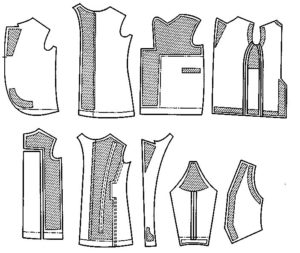
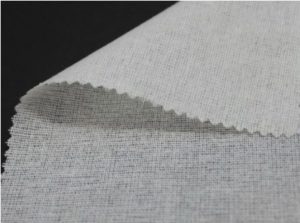
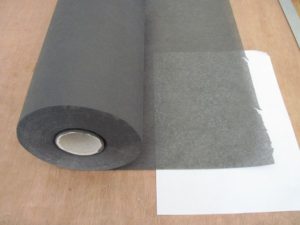
 0
0